Finance in Hospitality: Cost Analysis, Variance, and Ratio Evaluation
VerifiedAdded on 2020/06/06
|13
|2978
|45
Report
AI Summary
This report provides a comprehensive analysis of financial management within the hospitality industry. It begins by exploring various sources of funding for new and existing businesses, differentiating between personal investment, venture capital, bank loans, debentures, and retained earnings, and their respective advantages and disadvantages. The report then delves into income generation methods such as sales promotion, sub-letting, and sponsorship. A detailed examination of cost elements, including material, direct labor, and indirect expenses, is followed by an analysis of gross profit percentages, selling price determination, and methods for controlling stock and cash. The report further covers the creation and evaluation of trial balances, including adjustments for machinery costs and incorrect salary entries, alongside the preparation of trading and income statements. Budgetary control processes and their purposes are discussed, along with the calculation of variable cost variance. Finally, the report analyzes financial ratios, including sales growth, gross profit margin, net profit margin, stock turnover, and liquidity ratios, offering recommendations based on the findings. The report concludes with a review of cost categorization and contribution per unit calculations, justifying short-term management decisions based on the financial analysis.
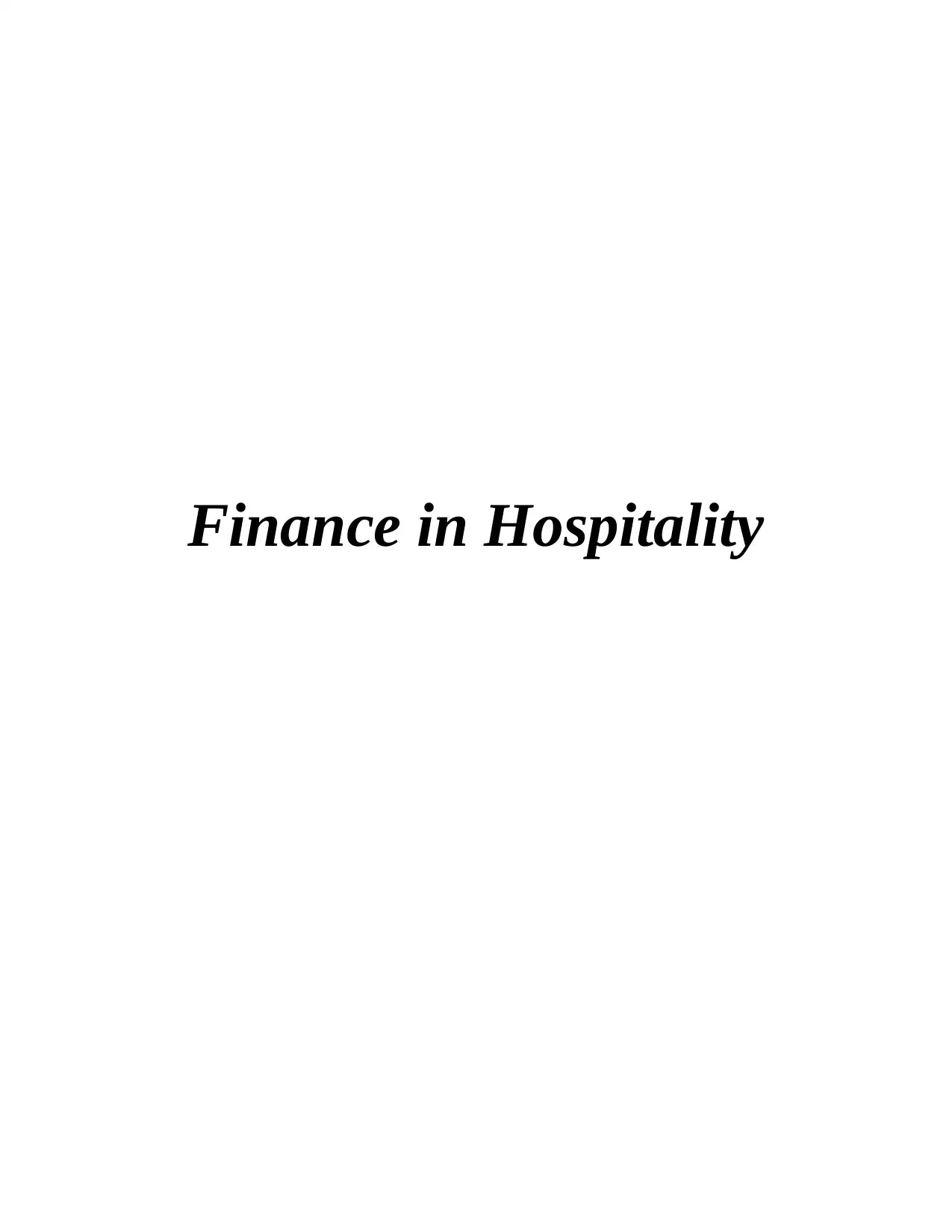
Finance in Hospitality
Paraphrase This Document
Need a fresh take? Get an instant paraphrase of this document with our AI Paraphraser
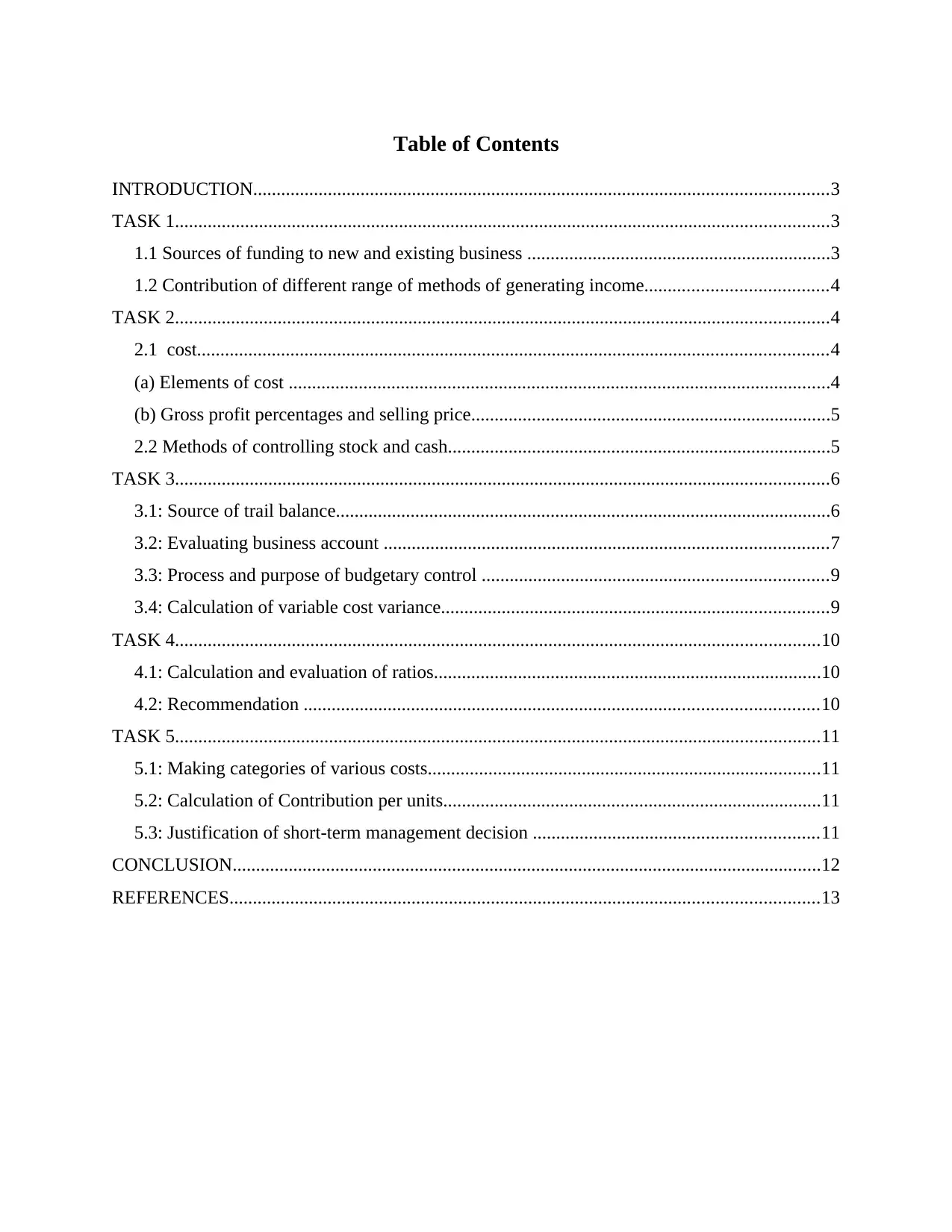
Table of Contents
INTRODUCTION...........................................................................................................................3
TASK 1............................................................................................................................................3
1.1 Sources of funding to new and existing business .................................................................3
1.2 Contribution of different range of methods of generating income.......................................4
TASK 2............................................................................................................................................4
2.1 cost.......................................................................................................................................4
(a) Elements of cost ....................................................................................................................4
(b) Gross profit percentages and selling price.............................................................................5
2.2 Methods of controlling stock and cash..................................................................................5
TASK 3............................................................................................................................................6
3.1: Source of trail balance..........................................................................................................6
3.2: Evaluating business account ...............................................................................................7
3.3: Process and purpose of budgetary control ..........................................................................9
3.4: Calculation of variable cost variance...................................................................................9
TASK 4..........................................................................................................................................10
4.1: Calculation and evaluation of ratios...................................................................................10
4.2: Recommendation ..............................................................................................................10
TASK 5..........................................................................................................................................11
5.1: Making categories of various costs....................................................................................11
5.2: Calculation of Contribution per units.................................................................................11
5.3: Justification of short-term management decision .............................................................11
CONCLUSION..............................................................................................................................12
REFERENCES..............................................................................................................................13
INTRODUCTION...........................................................................................................................3
TASK 1............................................................................................................................................3
1.1 Sources of funding to new and existing business .................................................................3
1.2 Contribution of different range of methods of generating income.......................................4
TASK 2............................................................................................................................................4
2.1 cost.......................................................................................................................................4
(a) Elements of cost ....................................................................................................................4
(b) Gross profit percentages and selling price.............................................................................5
2.2 Methods of controlling stock and cash..................................................................................5
TASK 3............................................................................................................................................6
3.1: Source of trail balance..........................................................................................................6
3.2: Evaluating business account ...............................................................................................7
3.3: Process and purpose of budgetary control ..........................................................................9
3.4: Calculation of variable cost variance...................................................................................9
TASK 4..........................................................................................................................................10
4.1: Calculation and evaluation of ratios...................................................................................10
4.2: Recommendation ..............................................................................................................10
TASK 5..........................................................................................................................................11
5.1: Making categories of various costs....................................................................................11
5.2: Calculation of Contribution per units.................................................................................11
5.3: Justification of short-term management decision .............................................................11
CONCLUSION..............................................................................................................................12
REFERENCES..............................................................................................................................13
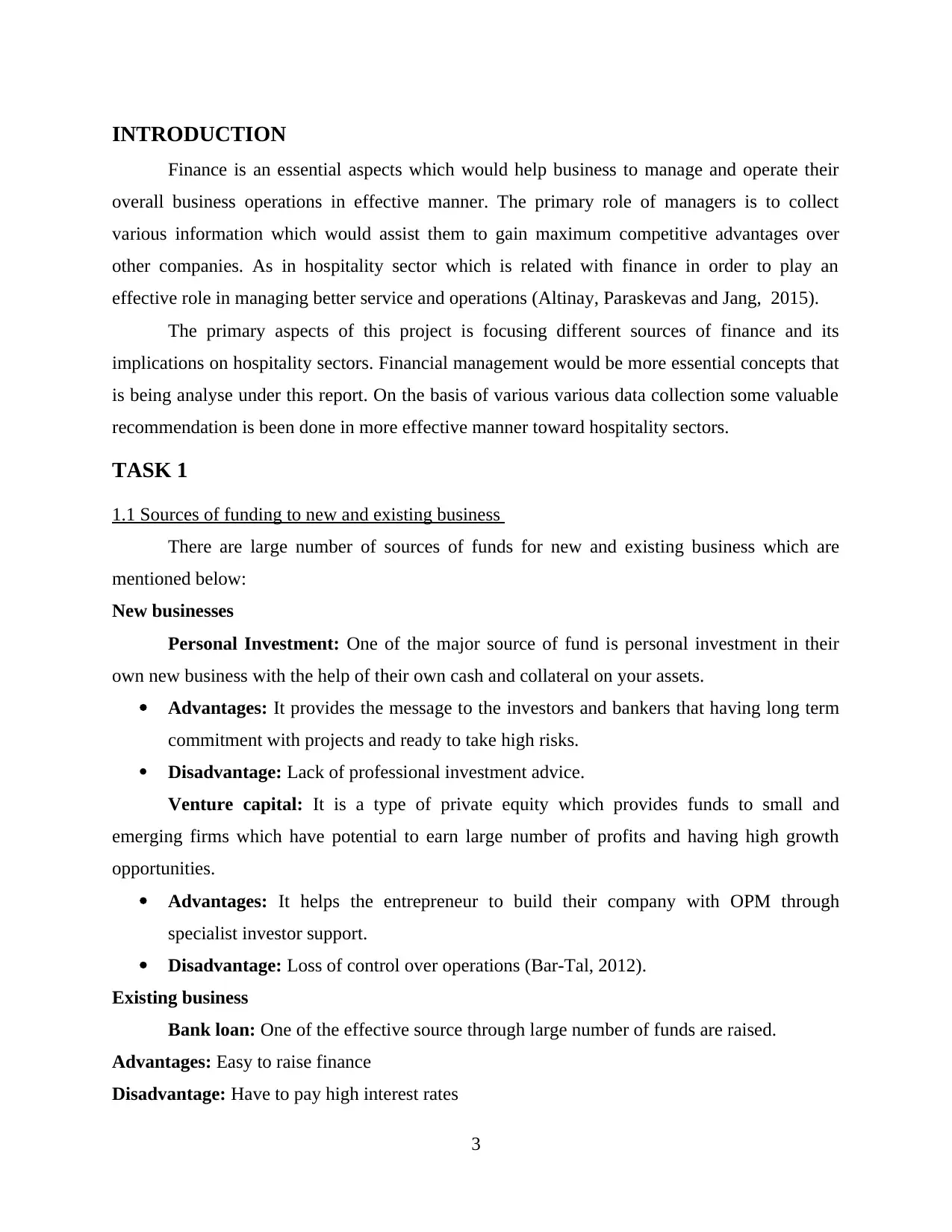
INTRODUCTION
Finance is an essential aspects which would help business to manage and operate their
overall business operations in effective manner. The primary role of managers is to collect
various information which would assist them to gain maximum competitive advantages over
other companies. As in hospitality sector which is related with finance in order to play an
effective role in managing better service and operations (Altinay, Paraskevas and Jang, 2015).
The primary aspects of this project is focusing different sources of finance and its
implications on hospitality sectors. Financial management would be more essential concepts that
is being analyse under this report. On the basis of various various data collection some valuable
recommendation is been done in more effective manner toward hospitality sectors.
TASK 1
1.1 Sources of funding to new and existing business
There are large number of sources of funds for new and existing business which are
mentioned below:
New businesses
Personal Investment: One of the major source of fund is personal investment in their
own new business with the help of their own cash and collateral on your assets.
Advantages: It provides the message to the investors and bankers that having long term
commitment with projects and ready to take high risks.
Disadvantage: Lack of professional investment advice.
Venture capital: It is a type of private equity which provides funds to small and
emerging firms which have potential to earn large number of profits and having high growth
opportunities.
Advantages: It helps the entrepreneur to build their company with OPM through
specialist investor support.
Disadvantage: Loss of control over operations (Bar-Tal, 2012).
Existing business
Bank loan: One of the effective source through large number of funds are raised.
Advantages: Easy to raise finance
Disadvantage: Have to pay high interest rates
3
Finance is an essential aspects which would help business to manage and operate their
overall business operations in effective manner. The primary role of managers is to collect
various information which would assist them to gain maximum competitive advantages over
other companies. As in hospitality sector which is related with finance in order to play an
effective role in managing better service and operations (Altinay, Paraskevas and Jang, 2015).
The primary aspects of this project is focusing different sources of finance and its
implications on hospitality sectors. Financial management would be more essential concepts that
is being analyse under this report. On the basis of various various data collection some valuable
recommendation is been done in more effective manner toward hospitality sectors.
TASK 1
1.1 Sources of funding to new and existing business
There are large number of sources of funds for new and existing business which are
mentioned below:
New businesses
Personal Investment: One of the major source of fund is personal investment in their
own new business with the help of their own cash and collateral on your assets.
Advantages: It provides the message to the investors and bankers that having long term
commitment with projects and ready to take high risks.
Disadvantage: Lack of professional investment advice.
Venture capital: It is a type of private equity which provides funds to small and
emerging firms which have potential to earn large number of profits and having high growth
opportunities.
Advantages: It helps the entrepreneur to build their company with OPM through
specialist investor support.
Disadvantage: Loss of control over operations (Bar-Tal, 2012).
Existing business
Bank loan: One of the effective source through large number of funds are raised.
Advantages: Easy to raise finance
Disadvantage: Have to pay high interest rates
3
⊘ This is a preview!⊘
Do you want full access?
Subscribe today to unlock all pages.

Trusted by 1+ million students worldwide
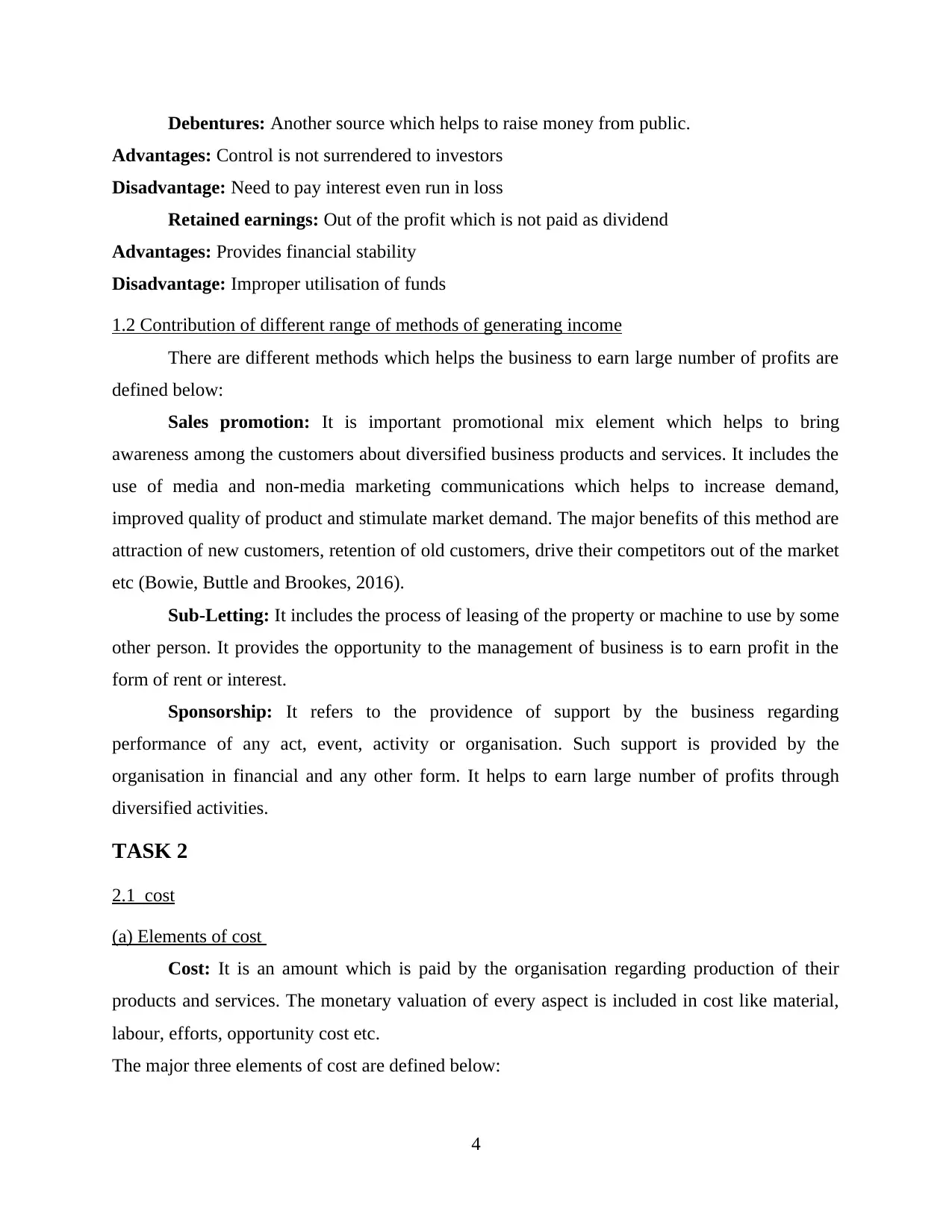
Debentures: Another source which helps to raise money from public.
Advantages: Control is not surrendered to investors
Disadvantage: Need to pay interest even run in loss
Retained earnings: Out of the profit which is not paid as dividend
Advantages: Provides financial stability
Disadvantage: Improper utilisation of funds
1.2 Contribution of different range of methods of generating income
There are different methods which helps the business to earn large number of profits are
defined below:
Sales promotion: It is important promotional mix element which helps to bring
awareness among the customers about diversified business products and services. It includes the
use of media and non-media marketing communications which helps to increase demand,
improved quality of product and stimulate market demand. The major benefits of this method are
attraction of new customers, retention of old customers, drive their competitors out of the market
etc (Bowie, Buttle and Brookes, 2016).
Sub-Letting: It includes the process of leasing of the property or machine to use by some
other person. It provides the opportunity to the management of business is to earn profit in the
form of rent or interest.
Sponsorship: It refers to the providence of support by the business regarding
performance of any act, event, activity or organisation. Such support is provided by the
organisation in financial and any other form. It helps to earn large number of profits through
diversified activities.
TASK 2
2.1 cost
(a) Elements of cost
Cost: It is an amount which is paid by the organisation regarding production of their
products and services. The monetary valuation of every aspect is included in cost like material,
labour, efforts, opportunity cost etc.
The major three elements of cost are defined below:
4
Advantages: Control is not surrendered to investors
Disadvantage: Need to pay interest even run in loss
Retained earnings: Out of the profit which is not paid as dividend
Advantages: Provides financial stability
Disadvantage: Improper utilisation of funds
1.2 Contribution of different range of methods of generating income
There are different methods which helps the business to earn large number of profits are
defined below:
Sales promotion: It is important promotional mix element which helps to bring
awareness among the customers about diversified business products and services. It includes the
use of media and non-media marketing communications which helps to increase demand,
improved quality of product and stimulate market demand. The major benefits of this method are
attraction of new customers, retention of old customers, drive their competitors out of the market
etc (Bowie, Buttle and Brookes, 2016).
Sub-Letting: It includes the process of leasing of the property or machine to use by some
other person. It provides the opportunity to the management of business is to earn profit in the
form of rent or interest.
Sponsorship: It refers to the providence of support by the business regarding
performance of any act, event, activity or organisation. Such support is provided by the
organisation in financial and any other form. It helps to earn large number of profits through
diversified activities.
TASK 2
2.1 cost
(a) Elements of cost
Cost: It is an amount which is paid by the organisation regarding production of their
products and services. The monetary valuation of every aspect is included in cost like material,
labour, efforts, opportunity cost etc.
The major three elements of cost are defined below:
4
Paraphrase This Document
Need a fresh take? Get an instant paraphrase of this document with our AI Paraphraser
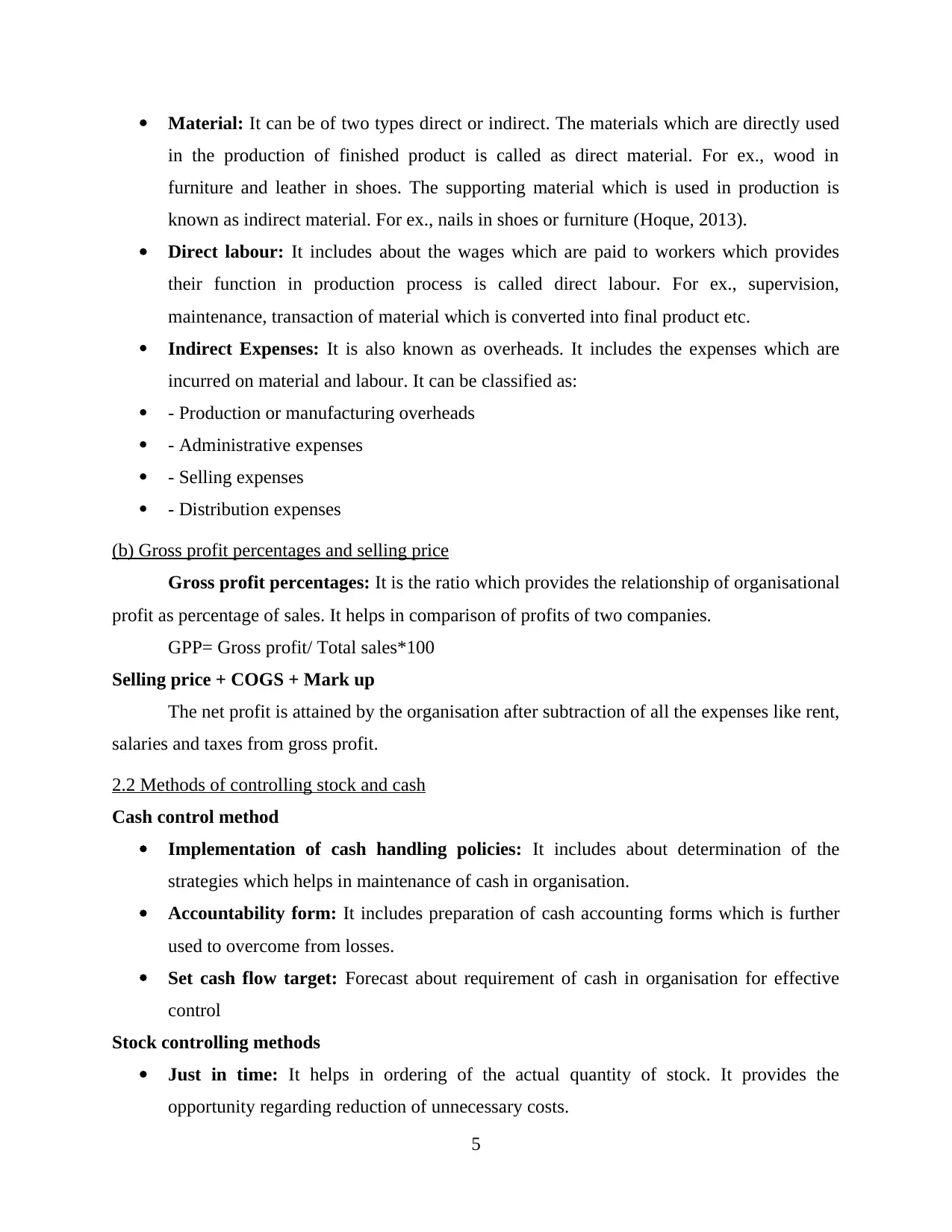
Material: It can be of two types direct or indirect. The materials which are directly used
in the production of finished product is called as direct material. For ex., wood in
furniture and leather in shoes. The supporting material which is used in production is
known as indirect material. For ex., nails in shoes or furniture (Hoque, 2013).
Direct labour: It includes about the wages which are paid to workers which provides
their function in production process is called direct labour. For ex., supervision,
maintenance, transaction of material which is converted into final product etc.
Indirect Expenses: It is also known as overheads. It includes the expenses which are
incurred on material and labour. It can be classified as:
- Production or manufacturing overheads
- Administrative expenses
- Selling expenses
- Distribution expenses
(b) Gross profit percentages and selling price
Gross profit percentages: It is the ratio which provides the relationship of organisational
profit as percentage of sales. It helps in comparison of profits of two companies.
GPP= Gross profit/ Total sales*100
Selling price + COGS + Mark up
The net profit is attained by the organisation after subtraction of all the expenses like rent,
salaries and taxes from gross profit.
2.2 Methods of controlling stock and cash
Cash control method
Implementation of cash handling policies: It includes about determination of the
strategies which helps in maintenance of cash in organisation.
Accountability form: It includes preparation of cash accounting forms which is further
used to overcome from losses.
Set cash flow target: Forecast about requirement of cash in organisation for effective
control
Stock controlling methods
Just in time: It helps in ordering of the actual quantity of stock. It provides the
opportunity regarding reduction of unnecessary costs.
5
in the production of finished product is called as direct material. For ex., wood in
furniture and leather in shoes. The supporting material which is used in production is
known as indirect material. For ex., nails in shoes or furniture (Hoque, 2013).
Direct labour: It includes about the wages which are paid to workers which provides
their function in production process is called direct labour. For ex., supervision,
maintenance, transaction of material which is converted into final product etc.
Indirect Expenses: It is also known as overheads. It includes the expenses which are
incurred on material and labour. It can be classified as:
- Production or manufacturing overheads
- Administrative expenses
- Selling expenses
- Distribution expenses
(b) Gross profit percentages and selling price
Gross profit percentages: It is the ratio which provides the relationship of organisational
profit as percentage of sales. It helps in comparison of profits of two companies.
GPP= Gross profit/ Total sales*100
Selling price + COGS + Mark up
The net profit is attained by the organisation after subtraction of all the expenses like rent,
salaries and taxes from gross profit.
2.2 Methods of controlling stock and cash
Cash control method
Implementation of cash handling policies: It includes about determination of the
strategies which helps in maintenance of cash in organisation.
Accountability form: It includes preparation of cash accounting forms which is further
used to overcome from losses.
Set cash flow target: Forecast about requirement of cash in organisation for effective
control
Stock controlling methods
Just in time: It helps in ordering of the actual quantity of stock. It provides the
opportunity regarding reduction of unnecessary costs.
5
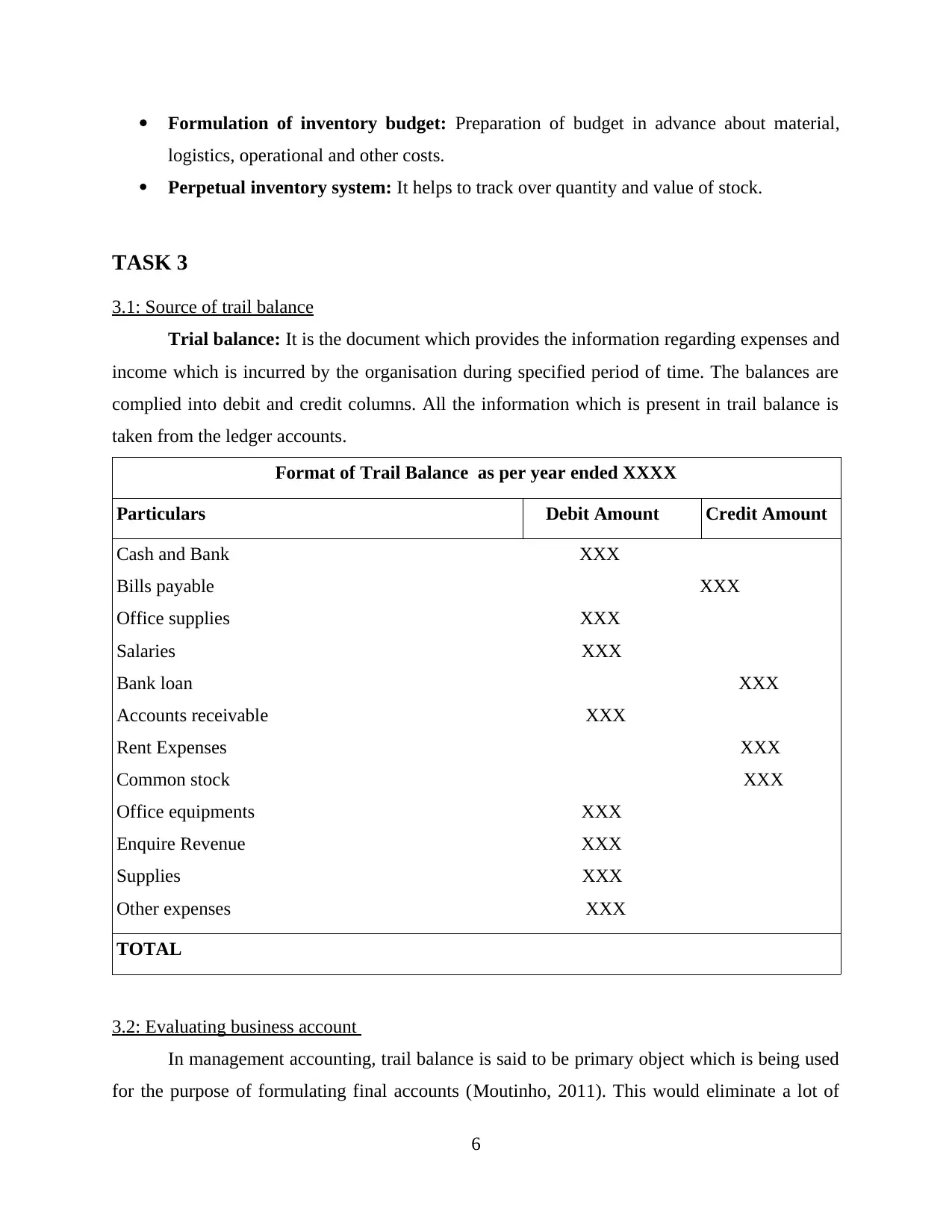
Formulation of inventory budget: Preparation of budget in advance about material,
logistics, operational and other costs.
Perpetual inventory system: It helps to track over quantity and value of stock.
TASK 3
3.1: Source of trail balance
Trial balance: It is the document which provides the information regarding expenses and
income which is incurred by the organisation during specified period of time. The balances are
complied into debit and credit columns. All the information which is present in trail balance is
taken from the ledger accounts.
Format of Trail Balance as per year ended XXXX
Particulars Debit Amount Credit Amount
Cash and Bank XXX
Bills payable XXX
Office supplies XXX
Salaries XXX
Bank loan XXX
Accounts receivable XXX
Rent Expenses XXX
Common stock XXX
Office equipments XXX
Enquire Revenue XXX
Supplies XXX
Other expenses XXX
TOTAL
3.2: Evaluating business account
In management accounting, trail balance is said to be primary object which is being used
for the purpose of formulating final accounts (Moutinho, 2011). This would eliminate a lot of
6
logistics, operational and other costs.
Perpetual inventory system: It helps to track over quantity and value of stock.
TASK 3
3.1: Source of trail balance
Trial balance: It is the document which provides the information regarding expenses and
income which is incurred by the organisation during specified period of time. The balances are
complied into debit and credit columns. All the information which is present in trail balance is
taken from the ledger accounts.
Format of Trail Balance as per year ended XXXX
Particulars Debit Amount Credit Amount
Cash and Bank XXX
Bills payable XXX
Office supplies XXX
Salaries XXX
Bank loan XXX
Accounts receivable XXX
Rent Expenses XXX
Common stock XXX
Office equipments XXX
Enquire Revenue XXX
Supplies XXX
Other expenses XXX
TOTAL
3.2: Evaluating business account
In management accounting, trail balance is said to be primary object which is being used
for the purpose of formulating final accounts (Moutinho, 2011). This would eliminate a lot of
6
⊘ This is a preview!⊘
Do you want full access?
Subscribe today to unlock all pages.

Trusted by 1+ million students worldwide
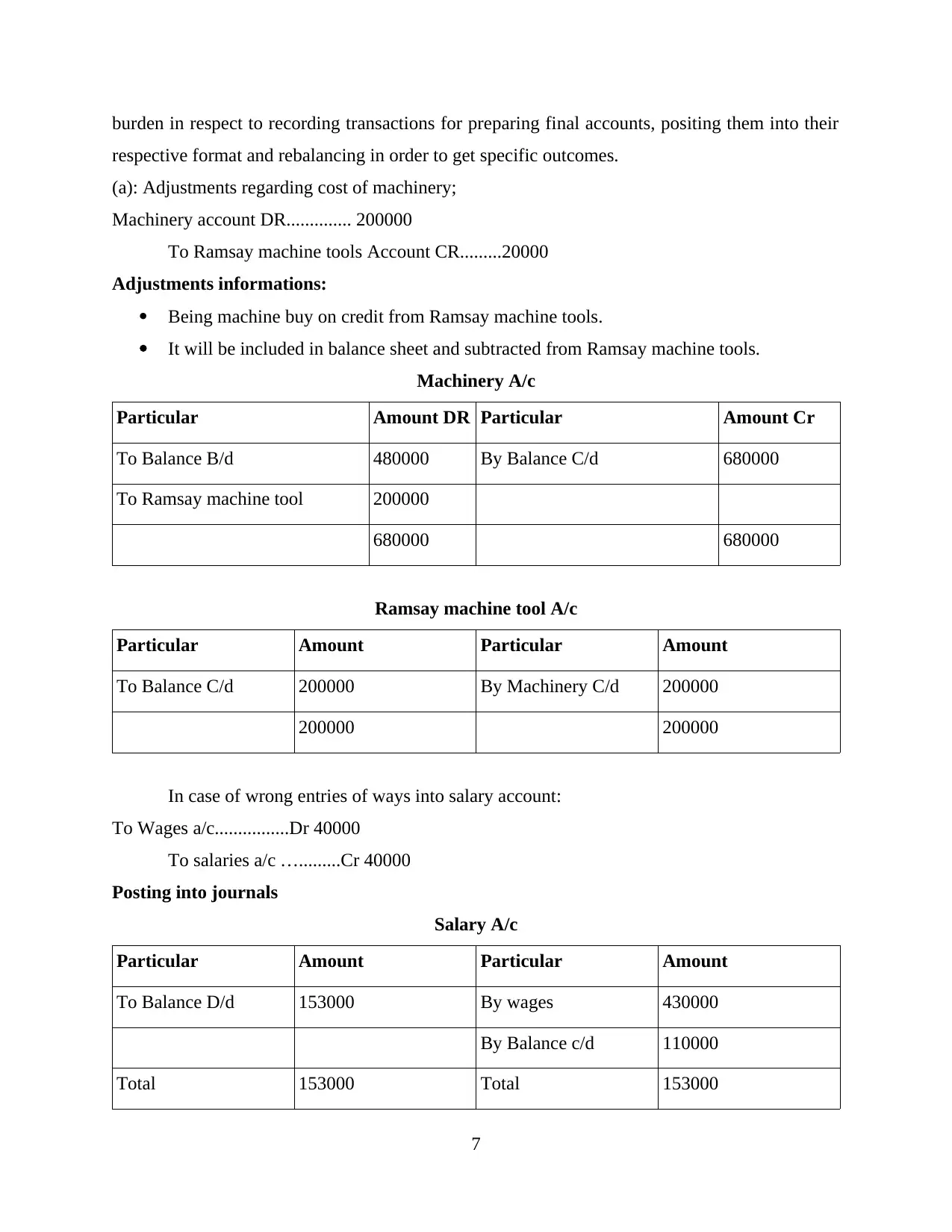
burden in respect to recording transactions for preparing final accounts, positing them into their
respective format and rebalancing in order to get specific outcomes.
(a): Adjustments regarding cost of machinery;
Machinery account DR.............. 200000
To Ramsay machine tools Account CR.........20000
Adjustments informations:
Being machine buy on credit from Ramsay machine tools.
It will be included in balance sheet and subtracted from Ramsay machine tools.
Machinery A/c
Particular Amount DR Particular Amount Cr
To Balance B/d 480000 By Balance C/d 680000
To Ramsay machine tool 200000
680000 680000
Ramsay machine tool A/c
Particular Amount Particular Amount
To Balance C/d 200000 By Machinery C/d 200000
200000 200000
In case of wrong entries of ways into salary account:
To Wages a/c................Dr 40000
To salaries a/c ….........Cr 40000
Posting into journals
Salary A/c
Particular Amount Particular Amount
To Balance D/d 153000 By wages 430000
By Balance c/d 110000
Total 153000 Total 153000
7
respective format and rebalancing in order to get specific outcomes.
(a): Adjustments regarding cost of machinery;
Machinery account DR.............. 200000
To Ramsay machine tools Account CR.........20000
Adjustments informations:
Being machine buy on credit from Ramsay machine tools.
It will be included in balance sheet and subtracted from Ramsay machine tools.
Machinery A/c
Particular Amount DR Particular Amount Cr
To Balance B/d 480000 By Balance C/d 680000
To Ramsay machine tool 200000
680000 680000
Ramsay machine tool A/c
Particular Amount Particular Amount
To Balance C/d 200000 By Machinery C/d 200000
200000 200000
In case of wrong entries of ways into salary account:
To Wages a/c................Dr 40000
To salaries a/c ….........Cr 40000
Posting into journals
Salary A/c
Particular Amount Particular Amount
To Balance D/d 153000 By wages 430000
By Balance c/d 110000
Total 153000 Total 153000
7
Paraphrase This Document
Need a fresh take? Get an instant paraphrase of this document with our AI Paraphraser
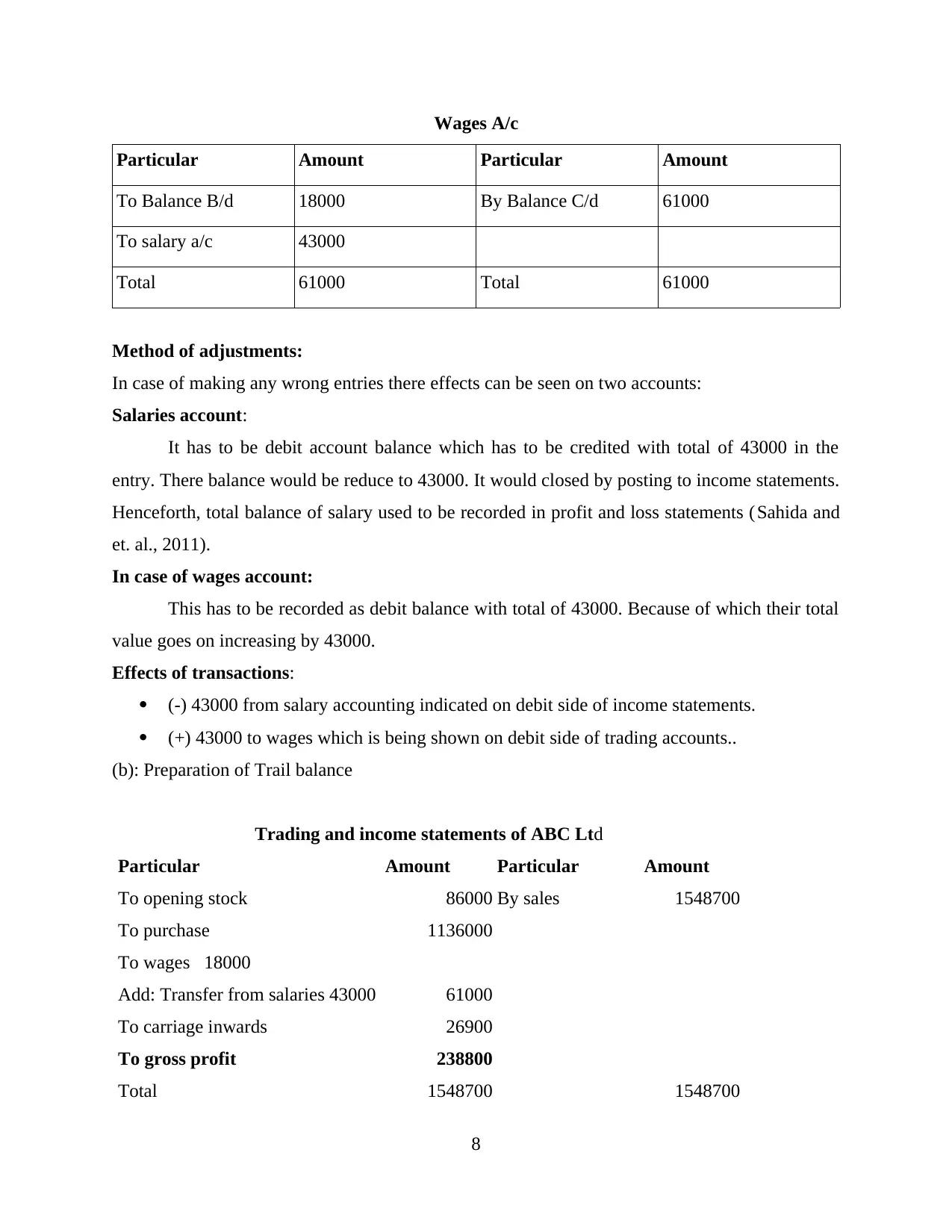
Wages A/c
Particular Amount Particular Amount
To Balance B/d 18000 By Balance C/d 61000
To salary a/c 43000
Total 61000 Total 61000
Method of adjustments:
In case of making any wrong entries there effects can be seen on two accounts:
Salaries account:
It has to be debit account balance which has to be credited with total of 43000 in the
entry. There balance would be reduce to 43000. It would closed by posting to income statements.
Henceforth, total balance of salary used to be recorded in profit and loss statements (Sahida and
et. al., 2011).
In case of wages account:
This has to be recorded as debit balance with total of 43000. Because of which their total
value goes on increasing by 43000.
Effects of transactions:
(-) 43000 from salary accounting indicated on debit side of income statements.
(+) 43000 to wages which is being shown on debit side of trading accounts..
(b): Preparation of Trail balance
Trading and income statements of ABC Ltd
Particular Amount Particular Amount
To opening stock 86000 By sales 1548700
To purchase 1136000
To wages 18000
Add: Transfer from salaries 43000 61000
To carriage inwards 26900
To gross profit 238800
Total 1548700 1548700
8
Particular Amount Particular Amount
To Balance B/d 18000 By Balance C/d 61000
To salary a/c 43000
Total 61000 Total 61000
Method of adjustments:
In case of making any wrong entries there effects can be seen on two accounts:
Salaries account:
It has to be debit account balance which has to be credited with total of 43000 in the
entry. There balance would be reduce to 43000. It would closed by posting to income statements.
Henceforth, total balance of salary used to be recorded in profit and loss statements (Sahida and
et. al., 2011).
In case of wages account:
This has to be recorded as debit balance with total of 43000. Because of which their total
value goes on increasing by 43000.
Effects of transactions:
(-) 43000 from salary accounting indicated on debit side of income statements.
(+) 43000 to wages which is being shown on debit side of trading accounts..
(b): Preparation of Trail balance
Trading and income statements of ABC Ltd
Particular Amount Particular Amount
To opening stock 86000 By sales 1548700
To purchase 1136000
To wages 18000
Add: Transfer from salaries 43000 61000
To carriage inwards 26900
To gross profit 238800
Total 1548700 1548700
8
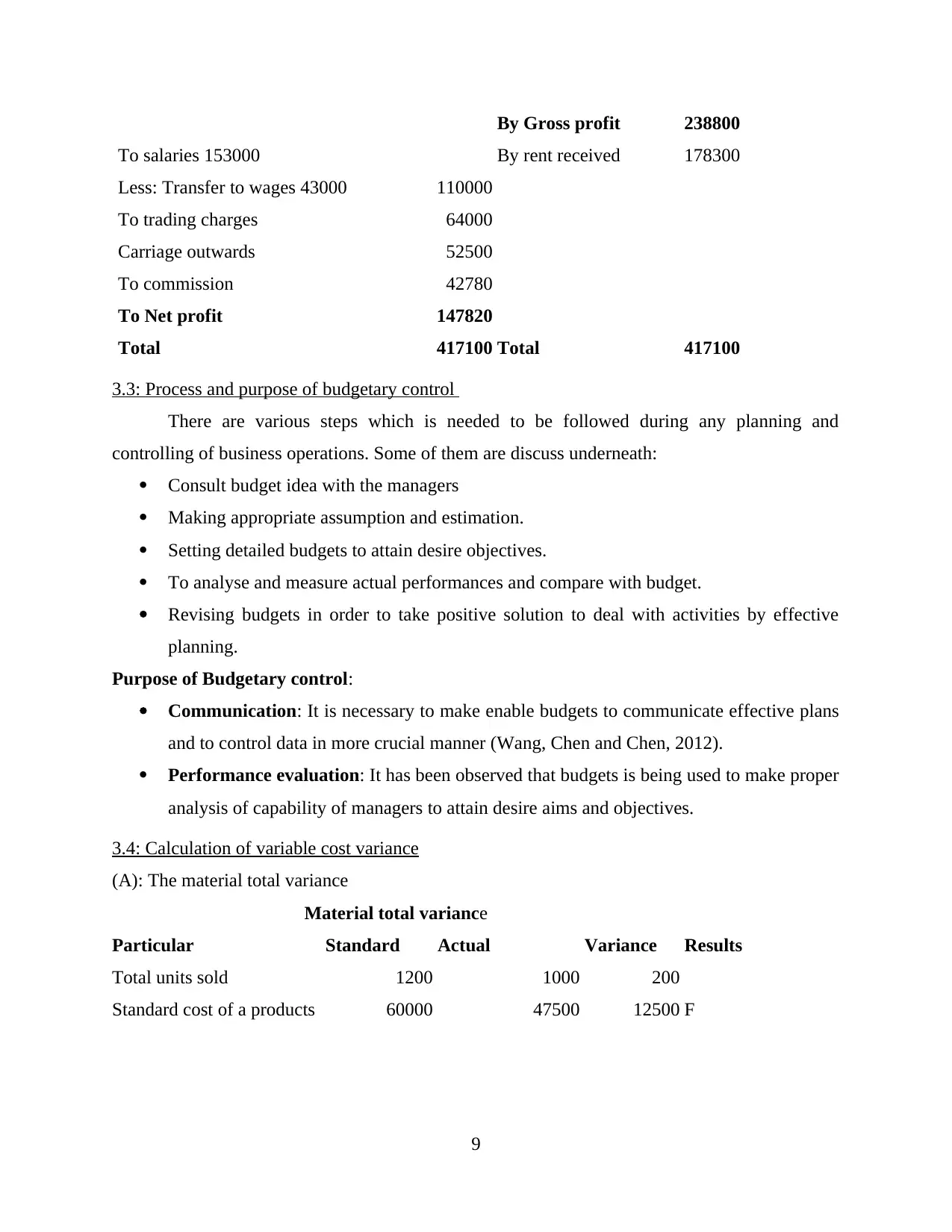
By Gross profit 238800
To salaries 153000 By rent received 178300
Less: Transfer to wages 43000 110000
To trading charges 64000
Carriage outwards 52500
To commission 42780
To Net profit 147820
Total 417100 Total 417100
3.3: Process and purpose of budgetary control
There are various steps which is needed to be followed during any planning and
controlling of business operations. Some of them are discuss underneath:
Consult budget idea with the managers
Making appropriate assumption and estimation.
Setting detailed budgets to attain desire objectives.
To analyse and measure actual performances and compare with budget.
Revising budgets in order to take positive solution to deal with activities by effective
planning.
Purpose of Budgetary control:
Communication: It is necessary to make enable budgets to communicate effective plans
and to control data in more crucial manner (Wang, Chen and Chen, 2012).
Performance evaluation: It has been observed that budgets is being used to make proper
analysis of capability of managers to attain desire aims and objectives.
3.4: Calculation of variable cost variance
(A): The material total variance
Material total variance
Particular Standard Actual Variance Results
Total units sold 1200 1000 200
Standard cost of a products 60000 47500 12500 F
9
To salaries 153000 By rent received 178300
Less: Transfer to wages 43000 110000
To trading charges 64000
Carriage outwards 52500
To commission 42780
To Net profit 147820
Total 417100 Total 417100
3.3: Process and purpose of budgetary control
There are various steps which is needed to be followed during any planning and
controlling of business operations. Some of them are discuss underneath:
Consult budget idea with the managers
Making appropriate assumption and estimation.
Setting detailed budgets to attain desire objectives.
To analyse and measure actual performances and compare with budget.
Revising budgets in order to take positive solution to deal with activities by effective
planning.
Purpose of Budgetary control:
Communication: It is necessary to make enable budgets to communicate effective plans
and to control data in more crucial manner (Wang, Chen and Chen, 2012).
Performance evaluation: It has been observed that budgets is being used to make proper
analysis of capability of managers to attain desire aims and objectives.
3.4: Calculation of variable cost variance
(A): The material total variance
Material total variance
Particular Standard Actual Variance Results
Total units sold 1200 1000 200
Standard cost of a products 60000 47500 12500 F
9
⊘ This is a preview!⊘
Do you want full access?
Subscribe today to unlock all pages.

Trusted by 1+ million students worldwide
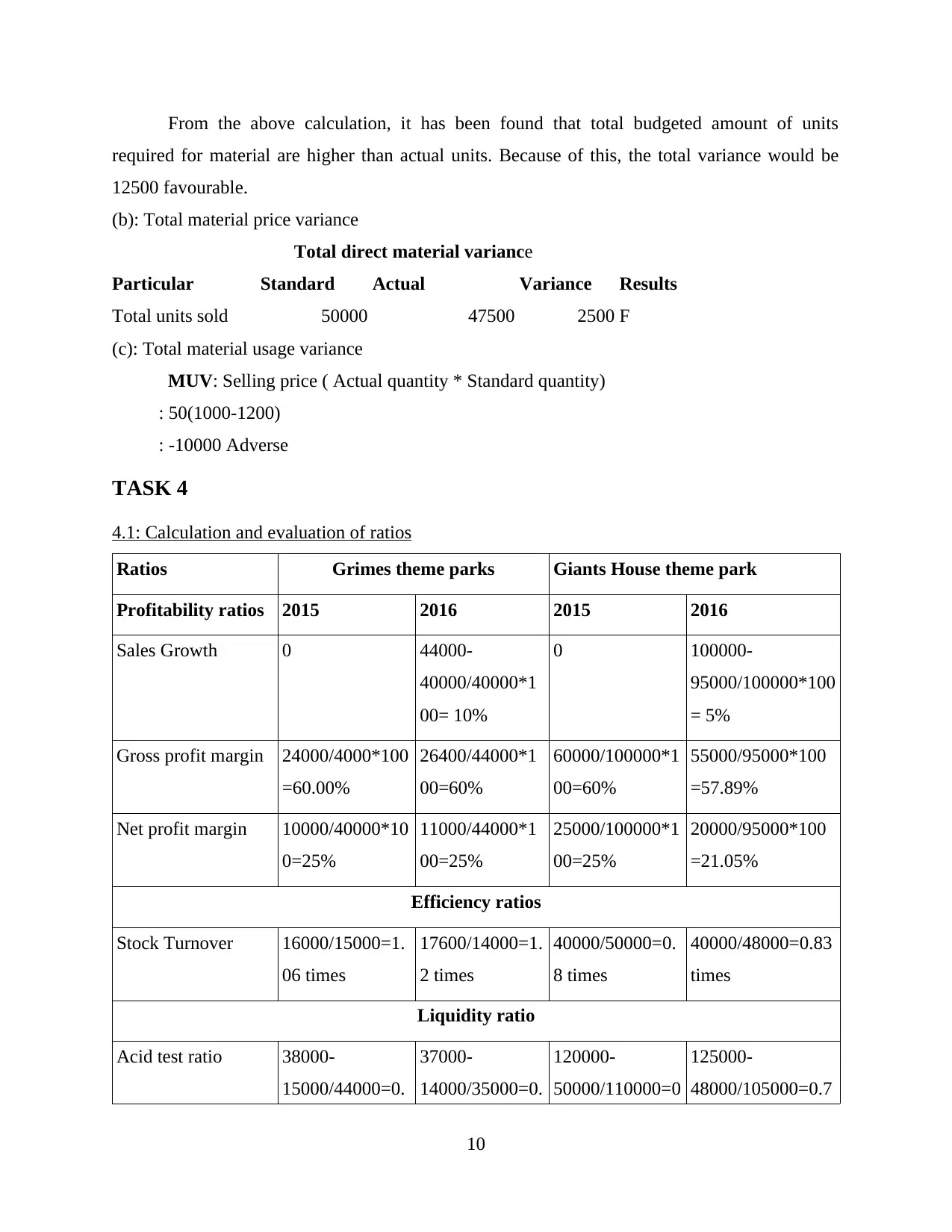
From the above calculation, it has been found that total budgeted amount of units
required for material are higher than actual units. Because of this, the total variance would be
12500 favourable.
(b): Total material price variance
Total direct material variance
Particular Standard Actual Variance Results
Total units sold 50000 47500 2500 F
(c): Total material usage variance
MUV: Selling price ( Actual quantity * Standard quantity)
: 50(1000-1200)
: -10000 Adverse
TASK 4
4.1: Calculation and evaluation of ratios
Ratios Grimes theme parks Giants House theme park
Profitability ratios 2015 2016 2015 2016
Sales Growth 0 44000-
40000/40000*1
00= 10%
0 100000-
95000/100000*100
= 5%
Gross profit margin 24000/4000*100
=60.00%
26400/44000*1
00=60%
60000/100000*1
00=60%
55000/95000*100
=57.89%
Net profit margin 10000/40000*10
0=25%
11000/44000*1
00=25%
25000/100000*1
00=25%
20000/95000*100
=21.05%
Efficiency ratios
Stock Turnover 16000/15000=1.
06 times
17600/14000=1.
2 times
40000/50000=0.
8 times
40000/48000=0.83
times
Liquidity ratio
Acid test ratio 38000-
15000/44000=0.
37000-
14000/35000=0.
120000-
50000/110000=0
125000-
48000/105000=0.7
10
required for material are higher than actual units. Because of this, the total variance would be
12500 favourable.
(b): Total material price variance
Total direct material variance
Particular Standard Actual Variance Results
Total units sold 50000 47500 2500 F
(c): Total material usage variance
MUV: Selling price ( Actual quantity * Standard quantity)
: 50(1000-1200)
: -10000 Adverse
TASK 4
4.1: Calculation and evaluation of ratios
Ratios Grimes theme parks Giants House theme park
Profitability ratios 2015 2016 2015 2016
Sales Growth 0 44000-
40000/40000*1
00= 10%
0 100000-
95000/100000*100
= 5%
Gross profit margin 24000/4000*100
=60.00%
26400/44000*1
00=60%
60000/100000*1
00=60%
55000/95000*100
=57.89%
Net profit margin 10000/40000*10
0=25%
11000/44000*1
00=25%
25000/100000*1
00=25%
20000/95000*100
=21.05%
Efficiency ratios
Stock Turnover 16000/15000=1.
06 times
17600/14000=1.
2 times
40000/50000=0.
8 times
40000/48000=0.83
times
Liquidity ratio
Acid test ratio 38000-
15000/44000=0.
37000-
14000/35000=0.
120000-
50000/110000=0
125000-
48000/105000=0.7
10
Paraphrase This Document
Need a fresh take? Get an instant paraphrase of this document with our AI Paraphraser
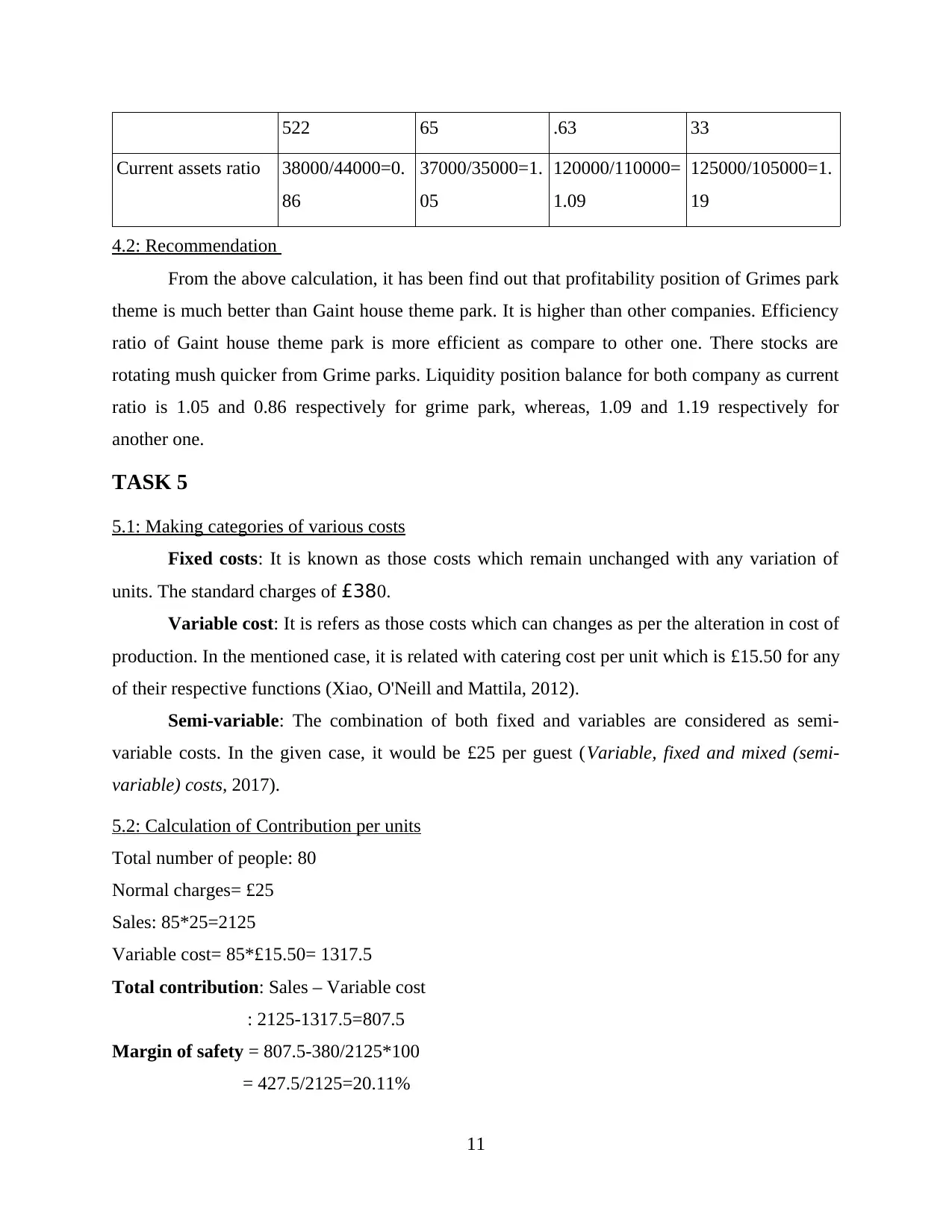
522 65 .63 33
Current assets ratio 38000/44000=0.
86
37000/35000=1.
05
120000/110000=
1.09
125000/105000=1.
19
4.2: Recommendation
From the above calculation, it has been find out that profitability position of Grimes park
theme is much better than Gaint house theme park. It is higher than other companies. Efficiency
ratio of Gaint house theme park is more efficient as compare to other one. There stocks are
rotating mush quicker from Grime parks. Liquidity position balance for both company as current
ratio is 1.05 and 0.86 respectively for grime park, whereas, 1.09 and 1.19 respectively for
another one.
TASK 5
5.1: Making categories of various costs
Fixed costs: It is known as those costs which remain unchanged with any variation of
units. The standard charges of £380.
Variable cost: It is refers as those costs which can changes as per the alteration in cost of
production. In the mentioned case, it is related with catering cost per unit which is £15.50 for any
of their respective functions (Xiao, O'Neill and Mattila, 2012).
Semi-variable: The combination of both fixed and variables are considered as semi-
variable costs. In the given case, it would be £25 per guest (Variable, fixed and mixed (semi-
variable) costs, 2017).
5.2: Calculation of Contribution per units
Total number of people: 80
Normal charges= £25
Sales: 85*25=2125
Variable cost= 85*£15.50= 1317.5
Total contribution: Sales – Variable cost
: 2125-1317.5=807.5
Margin of safety = 807.5-380/2125*100
= 427.5/2125=20.11%
11
Current assets ratio 38000/44000=0.
86
37000/35000=1.
05
120000/110000=
1.09
125000/105000=1.
19
4.2: Recommendation
From the above calculation, it has been find out that profitability position of Grimes park
theme is much better than Gaint house theme park. It is higher than other companies. Efficiency
ratio of Gaint house theme park is more efficient as compare to other one. There stocks are
rotating mush quicker from Grime parks. Liquidity position balance for both company as current
ratio is 1.05 and 0.86 respectively for grime park, whereas, 1.09 and 1.19 respectively for
another one.
TASK 5
5.1: Making categories of various costs
Fixed costs: It is known as those costs which remain unchanged with any variation of
units. The standard charges of £380.
Variable cost: It is refers as those costs which can changes as per the alteration in cost of
production. In the mentioned case, it is related with catering cost per unit which is £15.50 for any
of their respective functions (Xiao, O'Neill and Mattila, 2012).
Semi-variable: The combination of both fixed and variables are considered as semi-
variable costs. In the given case, it would be £25 per guest (Variable, fixed and mixed (semi-
variable) costs, 2017).
5.2: Calculation of Contribution per units
Total number of people: 80
Normal charges= £25
Sales: 85*25=2125
Variable cost= 85*£15.50= 1317.5
Total contribution: Sales – Variable cost
: 2125-1317.5=807.5
Margin of safety = 807.5-380/2125*100
= 427.5/2125=20.11%
11
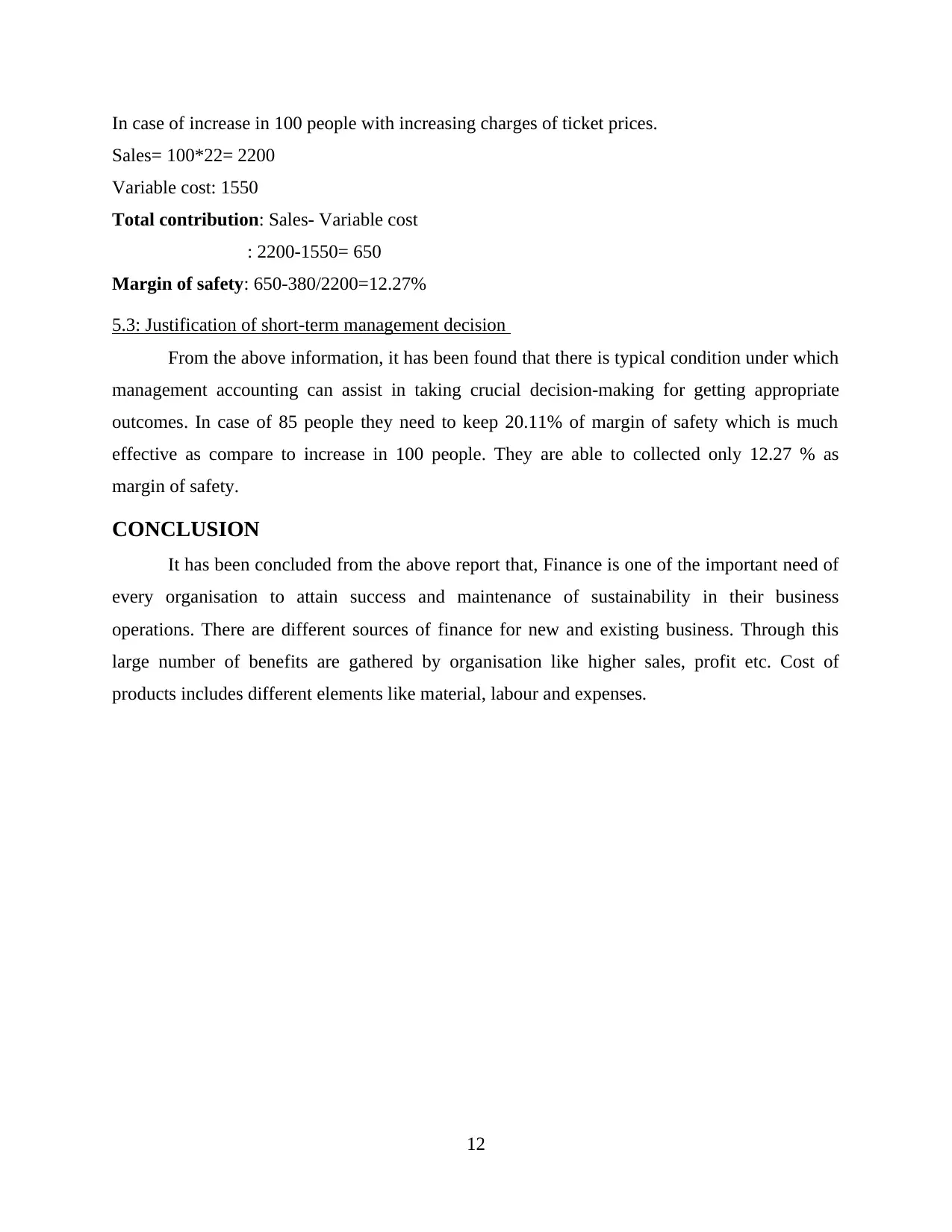
In case of increase in 100 people with increasing charges of ticket prices.
Sales= 100*22= 2200
Variable cost: 1550
Total contribution: Sales- Variable cost
: 2200-1550= 650
Margin of safety: 650-380/2200=12.27%
5.3: Justification of short-term management decision
From the above information, it has been found that there is typical condition under which
management accounting can assist in taking crucial decision-making for getting appropriate
outcomes. In case of 85 people they need to keep 20.11% of margin of safety which is much
effective as compare to increase in 100 people. They are able to collected only 12.27 % as
margin of safety.
CONCLUSION
It has been concluded from the above report that, Finance is one of the important need of
every organisation to attain success and maintenance of sustainability in their business
operations. There are different sources of finance for new and existing business. Through this
large number of benefits are gathered by organisation like higher sales, profit etc. Cost of
products includes different elements like material, labour and expenses.
12
Sales= 100*22= 2200
Variable cost: 1550
Total contribution: Sales- Variable cost
: 2200-1550= 650
Margin of safety: 650-380/2200=12.27%
5.3: Justification of short-term management decision
From the above information, it has been found that there is typical condition under which
management accounting can assist in taking crucial decision-making for getting appropriate
outcomes. In case of 85 people they need to keep 20.11% of margin of safety which is much
effective as compare to increase in 100 people. They are able to collected only 12.27 % as
margin of safety.
CONCLUSION
It has been concluded from the above report that, Finance is one of the important need of
every organisation to attain success and maintenance of sustainability in their business
operations. There are different sources of finance for new and existing business. Through this
large number of benefits are gathered by organisation like higher sales, profit etc. Cost of
products includes different elements like material, labour and expenses.
12
⊘ This is a preview!⊘
Do you want full access?
Subscribe today to unlock all pages.

Trusted by 1+ million students worldwide
1 out of 13
Related Documents
Your All-in-One AI-Powered Toolkit for Academic Success.
+13062052269
info@desklib.com
Available 24*7 on WhatsApp / Email
![[object Object]](/_next/static/media/star-bottom.7253800d.svg)
Unlock your academic potential
Copyright © 2020–2025 A2Z Services. All Rights Reserved. Developed and managed by ZUCOL.





